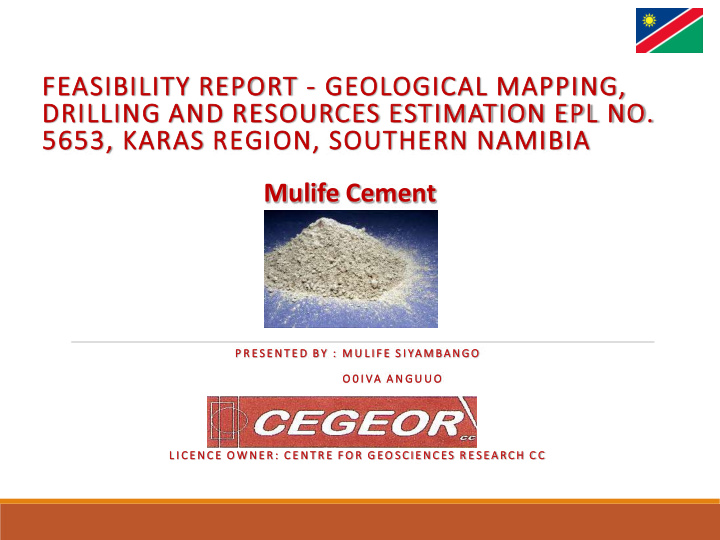



FEASIBILITY REPORT - GEOLOGICAL MAPPING, DRILLING AND RESOURCES ESTIMATION EPL NO. 5653, KARAS REGION, SOUTHERN NAMIBIA Mulife Cement P R E S EN T E D B Y : M U L I F E S I YA M BA NG O O 0 I VA A N G U U O L I C E N C E O W N ER : C E N T R E F O R G EO S CI EN C ES R E S EA RCH C C
Mulife Cement Namibia’s local indigenous cement production
Outline 1. Location, Trade links and Logistics 2. Exploration Methods 3. Topographic Mapping and Satellite Imagery 4. Aeromagnetic Magnetics 5. Drilling Programme 6. Local Geology 7. Limestone and Shales Resources and Reserves 8. Limestone and Shale Quality – Laboratory Results 9. Conclusions and Recommendations
END END What Namibia's current situation Namibia’s current cement consumption is 600 000 tons per year. - Namibia’s first cement factory, Ohorongo Cement, can produce - one million tons per year - Cheetah Cement produces around half a million tons per year - High infrastructure projects such as dams. Housing and habours has been the main driver of cement demand.
END END Expenses incurred to date Activity cost (Rands) Drilling 9,000,000 Environmental compliance 2,500,000 Business Consultancy 500,000 Licence matainace and operations 6,500,000 Geophysical Surveys 10,500,000 Geology 5,000,000 TOTAL 34,000,000
Location
Location
Trade Links Project Location on Farm Kaalberg 93
Local Infrastructure Support
Exploration Methods Used ✓ Topographic mapping and satellite imagery; ✓ High resolution geophysical data (aerial magnetics) acquisition and interpretation; ✓ Field geological mapping; ✓ Drilling; ✓ Field Sampling; ✓ Laboratory assessment for initial limestone and shale for grade control; and ✓ Assessment of the geological resources and ultimate initial ore reserve for possible test mining to be undertaken as part of the bankable feasibility.
Topographic and Satellite Imagery
Topographic and Satellite Imagery
Topographic and Satellite Imagery
Topographic and Satellite Imagery
Topographic and Satellite Imagery
Aeromagnetic Magnetics
Aeromagnetic Magnetics
Drilling Programme ✓ Implemented from the 10 th October 2009 and completed on the 24 th of October 2009; ✓ A total of 10 vertical holes 30 meters deep were drilled; ✓ Reverse Circulation (RC); ✓ Drilling contractor Eldorado Drilling cc; ✓ Drilling and sampling management company Profusion Investments were subcontracted to undertake the required field activities; ✓ Composites samples were collected at every 3 m.
Drilled Borehole Coordinates Drilling Programme Schwazerk (hddd.ddddd) UTM (m) HOLE X Y LAT LONG KRC01 738449 6984033 S27.24595 E017.40912 KRC02 733311 6991123 S27.18287 E017.35592 KRC03 738422 6994224 S27.15402 E017.40687 KRC04 733889 6987395 S27.18530 E017.42129 KRC05 739784 6990731 S27.26206 E017.36824 KRC06 734366 6982325 S27.26254 E017.43120 KRC07 740600 6982152 S27.30022 E017.41765 KRC08 739177 6978003 S27.29491 E017.40875 KRC09 739968 6977318 S27.21641 E017.36246 KRC10 738307 6978608 S27.30626 E017.42577
Drilling Programme
Drilling Programme Conclusions ✓ The drill hole defined the southern part of the limestone and shale deposits sufficient enough to support large scale cement / clinker project. If required further drilling could be done in the northern part of the EPL covering farm Totem 92; ✓ The ten boreholes drilled on farm Kaalberg 93 were widely spaced and will require infill and possibly deeper drilling in order to properly quantify the tonnage of limestone in the area as part of the full Bankable Feasibility Study (BFS) to be implemented;
Recommend
More recommend